Carnival Princes
The honorable title of Carnival Prince is bestowed on an individual who has left a mark on social and cultural life, actively promoted Kurentovanje, and has contributed to preserving the heritage of Kurents and Ptuj’s rich Carnival tradition.
At the opening of Kurentovanje, the Carnival Prince receives the town key from the mayor of Ptuj on behalf of all the carnival characters, along with the power to rule through the Carnival season - until Ash Wednesday. He is the protocol master of all main carnival events, and an ambassador of Kurentovanje, the town of Ptuj and carnival events at home and abroad during the Carnival season.
Since 2003, the Carnival Prince’s insignia, clothes and guards have been selected by historian Marija Hernja Masten to represent a historical figure from his birthplace.

The honorable title of Carnival Prince is bestowed on an individual who has left a mark on social and cultural life, actively promoted Kurentovanje, and has contributed to preserving the heritage of Kurents and Ptuj’s rich Carnival tradition.
At the opening of Kurentovanje, the Carnival Prince receives the town key from the mayor of Ptuj on behalf of all the carnival characters, along with the power to rule through the Carnival season - until Ash Wednesday. He is the protocol master of all main carnival events, and an ambassador of Kurentovanje, the town of Ptuj and carnival events at home and abroad during the Carnival season.
Since 2003, the Carnival Prince’s insignia, clothes and guards have been selected by historian Marija Hernja Masten to represent a historical figure from his birthplace.

Honorary President of the Council of Carnival Princes
The honorary president of Council of Carnival Princes FECC Ptuj, Slovenia, and general secretary of the Federation of European Carnival Cities (FECC) is also the mastermind behind the story of Ptuj’s Carnival Princes. He has been helping shape the story of Kurentovanje in different roles for over three decades. As the president of Kurentovanje, he has been promoting the festival locally, nationally and internationally for the past few years. In 2015, he was awarded the Medal of Merit by President of Slovenia Borut Pahor for passionately promoting Slovenian ethnographic heritage and successfully running Kurentovanje for 20 years.

20. princ ptujskega karnevala Miro Kokol
Novi princ ptujskega karnevala 2026-2027 je Miro Kokol, ki prihaja iz Destrnika, a živi na Ptuju. Deluje v društvu Koranti Destrnik, ki je bilo ustanovljeno na njegovo pobudo. 20. princ ptujskega karnevala predstavlja Jakoba Volovška, resnični zgodovinski vik iz 17. stoletja. Bil je preudaren, pameten, iznajdljiv in pogumen mož. Kot sin župana je moral mlad stopiti v službo svojega gospoda, ptujskega graščaka grofa Leslieja. Ta je kmalu spoznal njegove vrline in ga povzdignil v kapetana. S svojim gospodarjem je potoval po svetu ter nabiral izkušnje in modrost. Po vrnitvi na Ptuj je spoznal svojo življenjsko ljubezen Heleno. Okrog nje se je vrtel nasilen kovač Tomaž. Ta ga je zavrnila, saj so bila njena čustva naklonjena Jakobu. Užaljeni kovač je skupaj s prijatelji skoval zlobno maščevanje: Helenino domačijo je zažgal, Heleno pa ugrabil. Hrabri Jakob je z vojsko našel njegovo skrivališče in svojo ljubezen rešil, strahopetni Tomaž pa je pobegnil.
Več na povezavi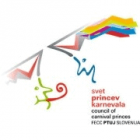
Chronological overview
princes of the carnival

1st Carnival Prince Jože Gašperšič
The first Carnival Prince of Kurentovanje, who started the successful story of Princes in Ptuj, was crowned on St. Martin’s Day in 1999. During his reign, he defined the Prince’s duties, and started the tradition of handing over the town key, symbolizing the transfer of power. He introduced Kurents to the global public with members of the Ptuj SKI Kurent club. He and his band of clowns in a Trabant are an indispensable part of the Carnival parade. He still serves as the President of Council of Carnival Princes.
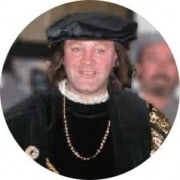
2nd Carnival Prince Zvonko Križaj
He chose his grandfather’s name Matevž, and added his nickname Zoki. Every year as a little boy, he eagerly awaited the start of Kurentovanje and for the midnight after Candlemas to strike, so he could don the bells. Matevž Zoki’s childhood memories also inspired the idea of the Kurent’s Jump - the symbolic start of Kurentovanje, which is held at his homestead in Budina pri Ptuju every year after Candlemas. He also manages the Kurent museum of traditional Carnival characters in his hometown.
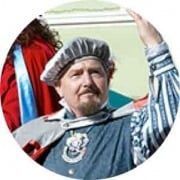
3rd Carnival Prince Zlatko Gajšek
The third Carnival Prince of Ptuj has been handing down the rich ethnographic traditions of Haloze to younger generations as Korant in a troupe of ploughmen. He is the first prince coming from outside the Ptuj municipality. He is dedicated to preserving the rituals of ploughmen’s door-to-door rounds, and the burial of Carnival in his local environment.

4th Carnival Prince Ivo Rajh
Ivo Rajh from Lančji dvor was the first prince to assume a name of a local historical figure. Simon Moscon was the last owner of the village of Lancova Vas and the Lančji Dvor manor in the second half of the 17th century. His background was explored and described by the renowned historian from Ptuj, Marija Hernja Masten. Since Noble Moschkon Rajh’s reign, each Carnival Prince has been given a title, clothes, and crest of a historical figure that left their mark in the prince’s place of origin.
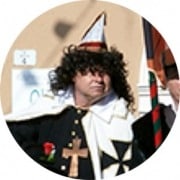
5th Carnival Prince Branko Cajnko
The fifth Prince of the Ptuj Carnival is the long-time president of the Koranti Poetovio Ptuj society. The prince represents Lord Friedrich II of Ptuj, an important member of the family of Lords of Ptuj, who took their name from the town of Ptuj in the Middle Ages. His clothes are modelled on the clothing of German knights from the late 18th century. During his reign, he started the tradition of princes meeting at the Sima bar on Prešernova ulica, which turns into a princes’ fortress for the occasion.
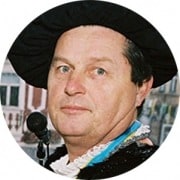
6th Carnival Prince Marjan Cajnko
The prince represents a member of the Medieval noble family of Hollnegk, who owned the Purgstall mansion in Rogoznica. To honor the milling tradition of the estate, his subject miller Matej plays the main role in the prince’s entourage. Marjan Cajnko is a long-time member of the Rogoznica cultural society, whose Koranti section is the oldest organized group of Kurents in the Ptuj area according to records. During his reign, the Council of Carnival Princes society was established.
Learn more: www.kdrogoznica.si

7th Carnival Prince Marko Klinc
Renowned upholsterer from Spuhlja pri Ptuju learned the trade and tradition of making Kurent costumes from his father, which is reflected in his crest that contains Kurent’s demonic mask. His character was inspired by a medieval commander of the marksmen’s guildhall in Spuhlja. The prince has been attending Carnival and medieval festivals with his guards and serfs from Spuhlja since the start of his reign. He is one of the biggest ambassadors of Kurentovanje. His KDFD Korant Spuhlja society holds the oldest fair with Kurent’s gear.
Learn more: www.korant-spuhlja.com
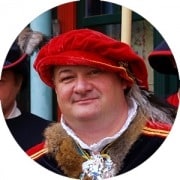
8th Carnival Prince Slavko Kolar
Slavko Kolar is a co-founder of the Ježevka ethnographic society that is headquartered in an old vinedresser’s house in Mestni Vrh. During his reign, he actively advocated for Shrove Tuesday to become a school holiday. He was named after Žiga Ivan Kacherl, a regional master of provisions, who owned the Kacherl mansion between the villages of Rabelčja Vas and Grajena. He wears extravagant clothes of a 17th century nobleman. He is the first Carnival Prince who served accompanied by his wife.
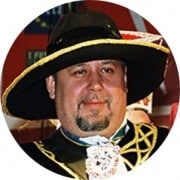
9th Carnival Prince Miran Urih
Miran Urih is an active member of the Cirkovce cultural society, which has been representing the ethnographic character of log-haulers. He is a member of the band called Pepi Krulet, which has become the official band of the Council of Carnival Princes. He is named after a rich civil servant from the late 18th century, who owned the women’s Dominican monastery in Studenice. His entourage includes the founders and donors of the Studenice monastery, Zofija Rogaška and her sister Rikarda. His reign was marked by extreme shortness of the Carnival season, with only 72 hours between Candlemas and Ash Wednesday. He ended his reign by presenting other princes with linden trees as national symbols, which the princes planted in their gardens.
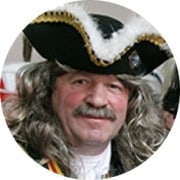
10th Carnival Prince Stanko Vegan
Stanko Vegan is a vital contributor to the ethnographic and carnival events of Kurentovanje, where he has been presenting original carnival masks with his colleagues from the KTD Klopotec Soviče-Dravci society. He especially likes performing as the old woman carrying her man. He was named after Janez Maximillian, Count of Thurn and Valsassina, who built the Turnišče castle and owned estates between the Dravsko Polje plain and Haloze hills. He is accompanied by his mother, Countess Suzana Elizabeta Thurn. He has been organizing the traditional princes’ walk with torches since 2009.

11th Carnival Prince Milan Senčar
The 11th Carnival Prince, who has been a Kurent since young age, chose: “I rule wisely, I do good,” as his motto. He also has his anthem. He was not accompanied by guards, but by a council of knights instead. He reigned in the year when Kurentovanje was held for the 50th time. He represents Lord Bernhard of Ptuj, a great patron of the arts and philanthropist, who is best known for commissioning the construction of the Basilica of the Mantled Virgin Mary the Protector at Ptujska Gora. He was a member of the family of Lords of Ptuj, who ruled Ptuj and its surroundings for ten generations between the 12th and 15th centuries.

12th Carnival Prince Janez Golc
Janez Golc comes from Markovci pri Ptuju, where the oldest written account of Kurents was created. He is a long-time member of the Anton Jože Štrafela Markovci folklore society, where he is involved as a folk dancer, spearman and Kurent. He represents Jakob Breuner, owner of estates near Ptuj, including the village of Markovci. Noble Baron Jakob Breuner of Markovci and his entourage have been making appearances at the medieval games. During Kurentovanje, he makes commemorative coins in his mint. He chose Muretinci castle as his residence, and holds medieval camps and baroque dinners there every summer.

13th Carnival Prince Vlado Hvalec
Vlado Hvalec has dedicated his life to rich ethnographic and cultural traditions and heritage. He was named after a 16th century castle commander and governor of Ptuj. A tombstone with his name and an inscription praising his military excellence is embedded in the wall of St. George’s Church in Ptuj. The prince’s garb reflects the wealth of the army commander. He has traditionally been attending the Ptuj promenade with his entourage of Lords of Ptuj. During his reign, Ptuj shared the title of the European Capital of Culture as a partner town. He was involved in securing the entry of Kurents’ door-to-door rounds on Unesco’s Representative List of the Intangible Cultural Heritage of Humanity as the president of the Association of Kurent Societies.
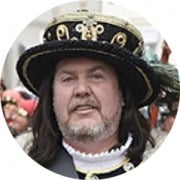
14th Carnival Prince Miroslav Slodnjak
Miroslav Slodnjak was the first prince to carry the scepter for two years. He is a member of the Cigani Dornava ethnographic society, which always contributes its cheerful disposition, dance and set to the folk and carnival parades. His character was inspired by the historical figure of the Knight of Dornava. He used the Dornava Castle as his residence during his reign. His costume is modelled on the clothes of a wealthy knight from the late 16th century. He is accompanied by Noble Lady Ana of Dornava.
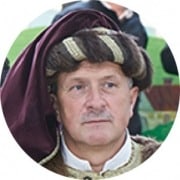
15th Carnival Prince Rajko Jurgec
Rajko Jurgec has been actively involved in the work of the Korenti society from Pobrežje since its beginnings. As a teacher, he has been passing on Carnival customs and traditions to new generations. His character was inspired by the famous Lords of Treun, specifically Bertold of Treun, a 13th century court marshal. The prince is accompanied by his lady, Noble Jožefa of Treun.

16th Carnival Prince Aleš Goričan
In addition to pursuing his calling as a Kurent, Aleš Goričan is also irreplaceable in his role as the Roman general Marcus Antonius Primus. He was named after Noble Janez Maksimilijan Gregorič, who managed Szekely’s estates and owned a few small castles in the Pesnica Valley and Slovenske Gorice in the 17th century. His insignia contains an image of Kurent. The prince is accompanied by his lady, Noble Ana Gregorič. He is the youngest prince in the history of the carnival.
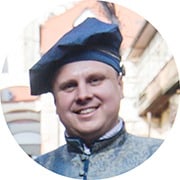
17th Carnival Prince Darko Cafuta
Darko Cafuta turned out to be an excellent promoter of the Carnival tradition as the prince. He attended not only the events of the 60th Kurentovanje, but also a number of other carnivals in Slovenia and abroad. He represents the feudal lord of Videm, Baron Jakob Zekel, who owned the Haloze estate with the seat in St. Vid. His costume was inspired by the late 16th century fashion.
Learn more: www.koranti-demoni.si

18th Carnival Prince
Hinko Šoštarič has been a member of the Sodinci tourism society since young age, helping preserve the ethnographic heritage. Members of the society have participated in a number of carnivals at home and abroad, wearing original masks made by him and his wife. He became the prince during the pandemic, which left a mark on both years of his reign. As a result, his reign was extended by one year. He was named after the knight who lived at the ancient Sodinci castle, a fortress with judicial powers that gave the village of Sodinci its name. The prince is accompanied by a beautiful lady of Slavic roots, Noble Stanka Gall.

19th Prince of Carnival Marko Šamperl
Princ ptujskega karnevala 2024-2026 je Ptujčan Marko Šamperl, ki prihaja iz četrtne skupnosti Spuhlja. Pri desetih letih je postal član društva Korant Spuhlja. Družina Šamperl je znana po svoji aktivni vlogi pri korantih, saj v društvu deluje že tretja generacija. 19. princ ptujskega karnevala predstavlja ptujskega mestnega sodnika in veletrgovca Francesca Guffanteja, ki je konec 15. stoletja prišel na Ptuj z italijanskimi družinami gradbenikov iz Lugana na jugu Švice, v italijansko govorečem delu današnjega kantona Ticino. Njegova vogalna hiša na Murkovi 2 spada med bolj poznane hiše Ptuja.
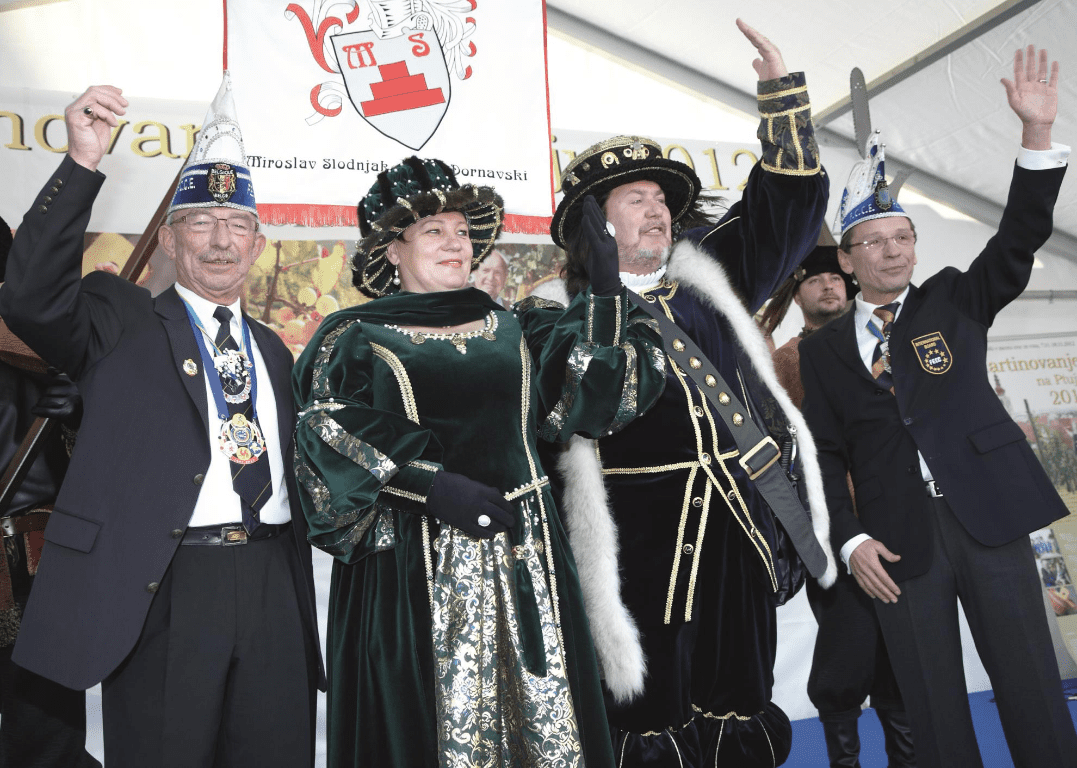
Within the Federation of European Carnival Cities (FECC), which brings together more than 550 cities and carnival organizers in 46 national associations, the figure prince of the carnival an important part of the tradition of carnival events and protocol. Ptuj and Slovenia have been members of the FECC since 1991. FECC President Henry van der Kroon has been urging Kurent leader Branko Brumn for several years to include Ptuj and Slovenia in making this traditional image of European carnival cities their biggest carnival.
In the first strategic turning point of the Kurentovanje concept in 1994, when an eleven-day event and a carnival hall were introduced, the decision to place the prince of the carnival had not yet been made, due to the awareness that the tradition of nine indigenous traditional carnival characters of our environment, with the Kurent-Korant at the forefront.
The new concept was upgraded in 1998 with the Meeting of Traditional Carnival Characters and Masks of Slovenia at the opening ceremony of Kurentovanje. In Ptuj, the function of the carnival prince was introduced in 1999 for the 2000 carnival year.
In designing the idea, the basic model of carnival princes in the cities and countries of the FECC was used, which was upgraded with a noble carnival tradition and the carnival spirit of our city and environment. If in European cities, where this function is extremely honorable, rich and successful citizens who feel like carnivals and are willing to participate in the organization as major financial sponsors and / or donors are mostly named Carnival Prince, the decision has been made in Ptuj to Honorary members of cultural and ethnographic societies, who actively participated in the organization and presentation of Kurentovanje at home and abroad, and above all preserve and nurture one of the traditional carnival characters of our environment.
The princes of the carnival were initially appointed by the director and organizing committee of Kurentovanje for a one-year term. Since the establishment of the Council of Carnival Princes in 2008, he has been appointed on the basis of a public call in agreement with the mayor and head of Kurentovanje. Since 2013, the prince has received a two-year term. The placement is on November 11, at 11 a.m. and 11 p.m., as Martin's Day is considered autumn desert oz. small carnival, the beginning of the winter carnival.
On St. Martin's Day in 1999, Jože Gašperšič from Ptuj was appointed the 1st Prince of the Carnival in Ptuj for the 2000 Carnival Year.

Within the Federation of European Carnival Cities (FECC), which brings together more than 550 cities and carnival organizers in 46 national associations, the figure prince of the carnival an important part of the tradition of carnival events and protocol. Ptuj and Slovenia have been members of the FECC since 1991. FECC President Henry van der Kroon has been urging Kurent leader Branko Brumn for several years to include Ptuj and Slovenia in making this traditional image of European carnival cities their biggest carnival.
In the first strategic turning point of the Kurentovanje concept in 1994, when an eleven-day event and a carnival hall were introduced, the decision to place the prince of the carnival had not yet been made, due to the awareness that the tradition of nine indigenous traditional carnival characters of our environment, with the Kurent-Korant at the forefront.
The new concept was upgraded in 1998 with the Meeting of Traditional Carnival Characters and Masks of Slovenia at the opening ceremony of Kurentovanje. In Ptuj, the function of the carnival prince was introduced in 1999 for the 2000 carnival year.
In designing the idea, the basic model of carnival princes in the cities and countries of the FECC was used, which was upgraded with a noble carnival tradition and the carnival spirit of our city and environment. If in European cities, where this function is extremely honorable, rich and successful citizens who feel like carnivals and are willing to participate in the organization as major financial sponsors and / or donors are mostly named Carnival Prince, the decision has been made in Ptuj to Honorary members of cultural and ethnographic societies, who actively participated in the organization and presentation of Kurentovanje at home and abroad, and above all preserve and nurture one of the traditional carnival characters of our environment.
The princes of the carnival were initially appointed by the director and organizing committee of Kurentovanje for a one-year term. Since the establishment of the Council of Carnival Princes in 2008, he has been appointed on the basis of a public call in agreement with the mayor and head of Kurentovanje. Since 2013, the prince has received a two-year term. The placement is on November 11, at 11 a.m. and 11 p.m., as Martin's Day is considered autumn desert oz. small carnival, the beginning of the winter carnival.
On St. Martin's Day in 1999, Jože Gašperšič from Ptuj was appointed the 1st Prince of the Carnival in Ptuj for the 2000 Carnival Year.
Public institution Ptuj
Organizer of Kurentovanje
Mestni trg 4,
SI-2250 Ptuj
T: +386 (0) 2 779 60 11
pr@kurentovanje.net
info@kurentovanje.net
Kurentovanje
We firmly believe that the internet should be available and accessible to anyone, and are committed to providing a website that is accessible to the widest possible audience, regardless of circumstance and ability.
To fulfill this, we aim to adhere as strictly as possible to the World Wide Web Consortium's (W3C) Web Content Accessibility Guidelines 2.1 (WCAG 2.1) at the AA level. These guidelines explain how to make web content accessible to people with a wide array of disabilities. Complying with those guidelines helps us ensure that the website is accessible to all people: blind people, people with motor impairments, visual impairment, cognitive disabilities, and more.
This website uses various technologies that are meant to make it as accessible as possible at all times. We utilize an accessibility interface that allows persons with specific disabilities to adjust the website's UI (user interface) and design it to their personal needs.
Additionally, the website utilizes an AI-based application that runs in the background and optimizes its accessibility level constantly. This application remediates the website's HTML, adapts its functionality and behavior for screen-readers used by blind users, and for keyboard functions used by individuals with motor impairments.
If you've found a malfunction or have ideas for improvement, we'll be happy to hear from you. You can reach out to the website's operators by using the following email
Our website implements the ARIA attributes (Accessible Rich Internet Applications) technique, alongside various different behavioral changes, to ensure blind users visiting with screen-readers are able to read, understand, and enjoy the website's functions. As soon as a user with a screen-reader enters your site, they immediately receive a prompt to enter the Screen-Reader Profile so they can browse and operate your site effectively. Here's how our website covers some of the most important screen-reader requirements, alongside console screenshots of code examples:
Screen-reader optimization: we run a background process that learns the website's components from top to bottom, to ensure ongoing compliance even when updating the website. In this process, we provide screen-readers with meaningful data using the ARIA set of attributes. For example, we provide accurate form labels; descriptions for actionable icons (social media icons, search icons, cart icons, etc.); validation guidance for form inputs; element roles such as buttons, menus, modal dialogues (popups), and others. Additionally, the background process scans all the website's images and provides an accurate and meaningful image-object-recognition-based description as an ALT (alternate text) tag for images that are not described. It will also extract texts that are embedded within the image, using an OCR (optical character recognition) technology. To turn on screen-reader adjustments at any time, users only need to press the Alt+1 keyboard combination. Screen-reader users also get automatic announcements to turn the Screen-reader mode on as soon as they enter the website.
These adjustments are compatible with all popular screen readers, including JAWS and NVDA.
Keyboard navigation optimization: The background process also adjusts the website's HTML, and adds various behaviors using JavaScript code to make the website operable by the keyboard. This includes the ability to navigate the website using the Tab and Shift+Tab keys, operate dropdowns with the arrow keys, close them with Esc, trigger buttons and links using the Enter key, navigate between radio and checkbox elements using the arrow keys, and fill them in with the Spacebar or Enter key. Additionally, keyboard users will find quick-navigation and content-skip menus, available at any time by clicking Alt+1, or as the first elements of the site while navigating with the keyboard. The background process also handles triggered popups by moving the keyboard focus towards them as soon as they appear, and not allowing the focus to drift outside it.
Users can also use shortcuts such as "M" (menus), "H" (headings), "F" (forms), "B" (buttons), and "G" (graphics) to jump to specific elements.
We aim to support the widest array of browsers and assistive technologies as possible, so our users can choose the best fitting tools for them, with as few limitations as possible. Therefore, we have worked very hard to be able to support all major systems that comprise over 95% of the user market share including Google Chrome, Mozilla Firefox, Apple Safari, Opera and Microsoft Edge, JAWS and NVDA (screen readers).
Despite our very best efforts to allow anyone to adjust the website to their needs. There may still be pages or sections that are not fully accessible, are in the process of becoming accessible, or are lacking an adequate technological solution to make them accessible. Still, we are continuously improving our accessibility, adding, updating and improving its options and features, and developing and adopting new technologies. All this is meant to reach the optimal level of accessibility, following technological advancements. For any assistance, please reach out to